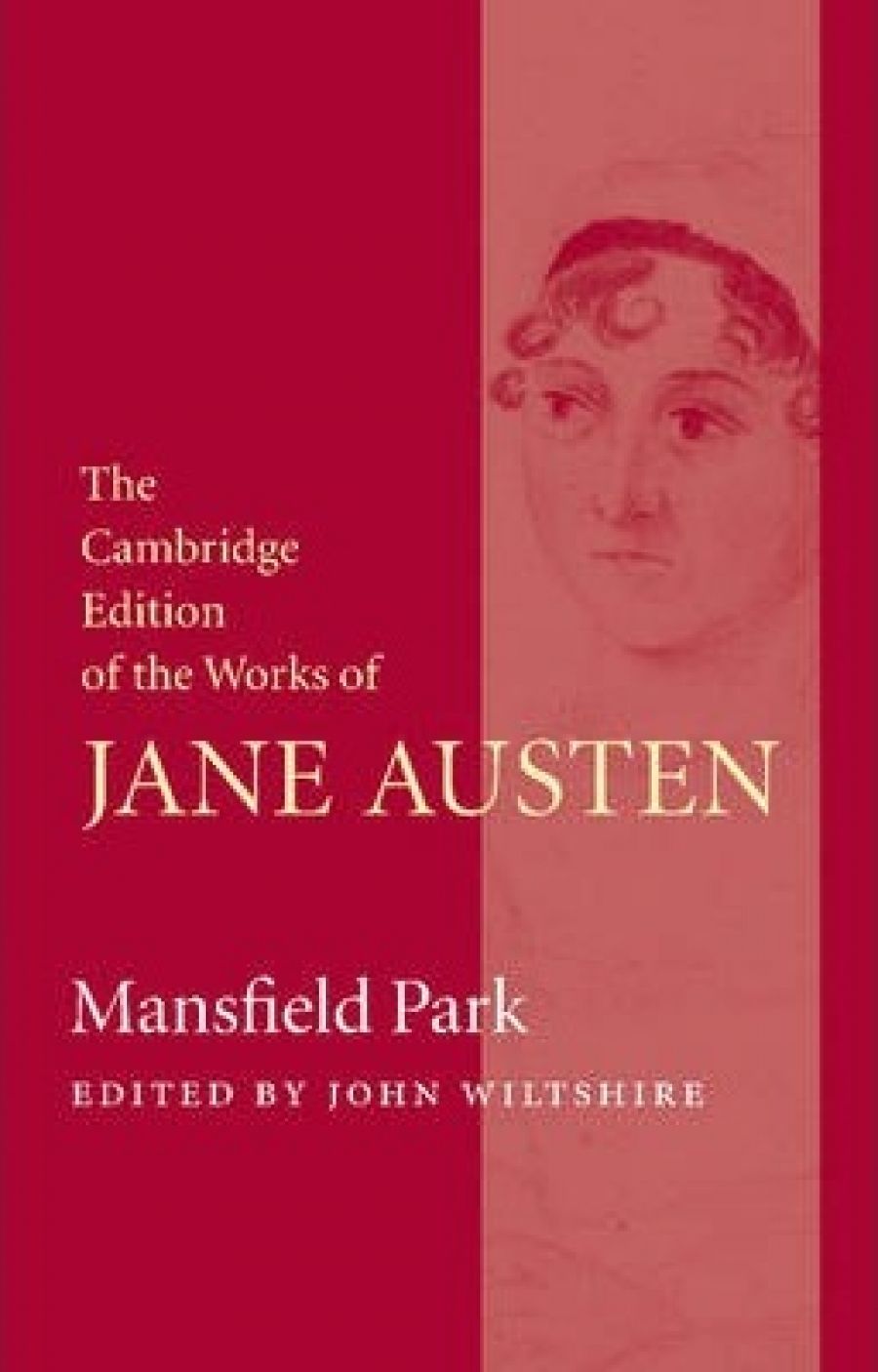
- Free Article: No
- Contents Category: Fiction
- Review Article: Yes
- Online Only: No
- Custom Highlight Text:
Why do we need another edition of Mansfield Park? Particularly, what is the justification for an expensive one, when we can get a plain reprint for $5, or a well-annotated paperback for $10? The answer is the one that all scholarly editors are driven by: editorial principles have changed. What was considered acceptable textual practice even twenty years ago no longer fulfils readers’ desires to get close to origins, to understand contexts.
- Book 1 Title: Mansfield Park
- Book 1 Readings Link: CUP, $199 hb, 824 pp
Mansfield Park (1814) is one of two novels (the other is Sense and Sensibility [1811]) that went into a second edition during Austen’s life (1775–1817). Countering Kathryn Sutherland’s preference for the first edition’s dash-laden punctuation, random capitalisation and occasional grammatical looseness – which Sutherland, Oxford Professor of Textual Criticism, claims represents the author’s ‘voice’ more closely – Wiltshire has chosen to use the second edition as copy-text, even though he concedes that the corrections are as likely to have been made by in-house compositors as by Austen herself. (The variants are reproduced at the foot of each page, so that readers can decide for themselves.)
More interesting to most readers, no doubt, are the extensive notes that Wiltshire has provided for a twenty-first century readership. Unfamiliar words, and words that have changed their meaning – ‘work’, for a lady, meaning needlework, ‘embarrassed’ used to signify ‘perplexed’, and so on – have a place beside the more arcane historical and social details that require explanation. There are one hundred pages of explanatory notes, all offering clarity and good sense. Much of this has been covered by earlier annotators, such as the vogue for ‘improving’ the landscape, or the significance of the play Lovers’ Vows for the Mansfield theatricals (the full text of Inchbald’s play is included in this edition). But there is unexpected illumination from other annotations based on completely new research.
Mary Crawford’s harp, for example, is probably the new Erard double-action harp, whose ‘mechanism meant that the instrument could be played in any key by the simple expedient of fixing the pedals in the requisite notes in a box at the base of the harp, making it rather easier to give a competent performance on the harp than on the piano’. That information does underline our sense of Mary’s meretricious charm, something that Austen has already indicated in observing that Mary knows she looks good playing an instrument designed to show off the arms and upper body of the performer: ‘A young woman, pretty, lively, with a harp as elegant as herself; and both placed near a window … was enough to catch any man’s heart.’
By contrast, Portsmouth and its inhabitants – Fanny’s original environment – are far worse than this reader had inferred. Wiltshire makes the point that contemporary readers would have known of its ‘ugly and dangerous’ aspects: ‘Full of sailors on leave or awaiting ships, marines awaiting a posting, workmen and convicts at the dockyards … Portsmouth was notorious for its prostitutes and rowdiness.’ Fanny, sent home by her uncle to learn a lesson about the advantages of Henry Crawford’s offer of marriage, is almost literally imprisoned in the mean little terrace-house she was born in. She cannot go into the streets without protective male company. Her drunken father, a lieutenant of Marines, we now understand to be a professional thug: the Marines were ‘a body of armed men employed to carry out policing duties on board ship and on shore in the large naval dockyards’. Mr Price has never been an active sailor, a gallant member of ‘that profession which is, if possible, more distinguished in its domestic virtues than in its national importance’, as the last words of Persuasion (1818) have it.
Wiltshire adds usefully to the current critical fashion for reading the novel as an intervention in the slavery debates by citing Hannah More’s 1805 pamphlet ‘The White Slave Trade’: ‘A multitude of fine fresh young slaves are annually imported at the age of seventeen or eighteen: or, according to the phrase of the despot, [Society] they come out.’ Fanny is the unwilling exemplar of this trade in the novel’s second and third volumes; and it is she, appropriately, who asks Sir Thomas about the slave trade in the West Indies (we don’t hear his answer).
In his introduction, Wiltshire offers a judicious survey of changes in critical readings of Mansfield Park, as well as making his own claims for it as an anti-romance: ‘At almost every turn, [Austen’s] writing deflects the reader’s desires for a simply satisfying, or fantasy resolution.’ He sees the novel’s basic conflict as that between passion and principle – the ‘seriousness’ that is contiguous to, but not identical with, the Evangelical turn in Anglicanism at the time. But Fanny is no stolid prig: she has an ‘urgent inner life’, and the novel charts its ‘relation to her outward demeanour’. Readers of this new edition of Austen’s most serious novel will find much to savour and reflect on in this beautifully produced volume.


Comments powered by CComment